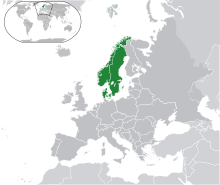ස්කැන්ඩිනේවියාව
 | |
| භූමිප්රමාණය | 928,057 km2 (358,325 sq mi) |
|---|---|
| ජනගහණය | ~21 million (2017) |
| ජනගහණ ඝණත්වය | 22.7/km2 (58.7/sq mi) |
| ජාතිකත්ව නාමය | ස්කැන්ඩිනේවියානුවන් |
| රටවල් | සමහර අවස්ථා වලදී:[1] ෆින්ලන්තය අයිස්ලන්තය ෆෙරෝ දුපත එලන්ඩ් දූපත |
| භාෂා |
ප්රාදේශීය භාෂා: |
| වේලා කලාප | UTC+1 UTC+2 (DST) |
| අන්තර්ජාලය TLD | |
ස්කැන්ඩිනේවියාව / ˌskændɪneɪviə / යනු උතුරු යුරෝපයේ සංස්කෘතික උතුරු ජර්මානු උරුමය සහ අන්යොන්යව තේරුම්ගත හැකි උතුරු ජර්මානු භාෂාවන්ගෙන් සමන්විත උතුරු යුරෝපයේ කලාපයකි. ඩෙන්මාර්කය, නෝර්වේ සහ ස්වීඩනය යන රටවලට පොදුවේ ස්කැන්ඩිනේවියා ලෙස කියයි. නමුත් ඉංග්රීසි භාවිතය තුළ එය ඇතැම් විට ස්කැන්ඩිනේවියානු අර්ධද්වීපය ලෙස භාවිතා කරයි මෙයට ෆින්ලන්තය සහ අයිස්ලන්තය යන රටවල්ද අයත් වෙ. මෙම පුළුල් ප්රදේශය සාමාන්යයෙන් නෝර්වීජියානු රටවල් ලෙස හැඳින්වේ
ස්කැන්ඩිනේවියාහි කොටසක් ලෙස දුර බැහැර ස්වල්බාර්ඩ් හා ජේන් මයිනීන් නෝර්වීජියානු දූපත් අයිති නොවේ.මේවා ග්රීන්ලන්තය ටද අයිති නොවේ. ඩෙන්මාර්කයේ ෆාරෝ දූපත් ද ඇතුළත් විය හැකිය.[4]
භාවිතය
[සංස්කරණය]
"ස්කැන්ඩිනේවියා" යනු ඩෙන්මාර්කය, නෝර්වේ සහ ස්වීඩනයයි. සමහර ප්රභවයන් තර්ක කරන්නේ ෆාරු දූපත්, ෆින්ලන්තය සහ අයිස්ලන්තය ඇතුලත් කර ගැනීම සඳහායි. නමුත් එම කලාපය සාමාන්යයෙන් හදුන්වන්නේ නෝර්ඩන් ලෙස හෝ නෝර්ඩික් රටවල් ලෙසයි.[5]


ස්කැන්ඩිනේවියාව ඩෙන්මාර්කය, නෝර්වේ සහ ස්වීඩනය සඳහා පහසු පොදු පදයක් ලෙස භාවිතා කිරීම මෑත කාලීනය. ඇතැම් ඉතිහාසඥයන් පවසන පරිදි, පොදු උරුමය පිළිබඳ අදහස් ප්රකාශයට පත් වූ මුල් අවධියේ සාහිත්යමය හා භාෂාමය ස්කැන්ඩිනේවවාදයක් බවට පත් වී ඇති අතර, එය දහ අට වන සියවසේදී සම්මත කර ගෙන හඳුන්වා දෙන ලදී.
සටහන්
[සංස්කරණය]පරිශීලනය
[සංස්කරණය]- ^ "Definition of Scandinavia in English". Oxford Dictionaries. සම්ප්රවේශය 23 December 2016.
A large peninsula in north-western Europe, occupied by Norway and Sweden … A cultural region consisting of the countries of Norway, Sweden, and Denmark and sometimes also of Iceland, Finland, and the Faroe Islands
- ^ a b "Languages". Nordic Cooperation. සම්ප්රවේශය 8 July 2017.
- ^ a b Landes, David (1 July 2009). "Swedish becomes official 'main language'". The Local (Se). සම්ප්රවේශය 8 July 2017.
- ^ "Scandinavia". Encyclopædia Britannica. 2009. සම්ප්රවේශය 28 October 2009.
Scandinavia, historically Scandia, part of northern Europe, generally held to consist of the two countries of the Scandinavian Peninsula, Norway and Sweden, with the addition of Denmark. Some authorities argue for the inclusion of Finland on geologic and economic grounds and of Iceland and the Faroe Islands on the grounds that their inhabitants speak Scandinavian languages related to those of Norway and Sweden and also have similar cultures.
- ^ "About Nordic co-operation". Nordic Council of Ministers & Nordic Council. 1 ඔක්තෝබර් 2007. 26 මාර්තු 2014 දින මුල් පිටපත වෙතින් සංරක්ෂණය කරන ලදී. සම්ප්රවේශය 25 මාර්තු 2014.
Denmark, Finland, Iceland, Norway, Sweden and the Faroe Islands, Greenland and Åland work together in the official Nordic co-operation.
පිටත සබැඳි
[සංස්කරණය]-
{{cite web}}: Empty citation (help) - Nordic Council – Official site for co-operation in the Nordic region
- Nordregio – Site established by the Nordic Council of Ministers
- vifanord – a digital library that provides scientific information on the Nordic and Baltic countries as well as the Baltic region as a whole
